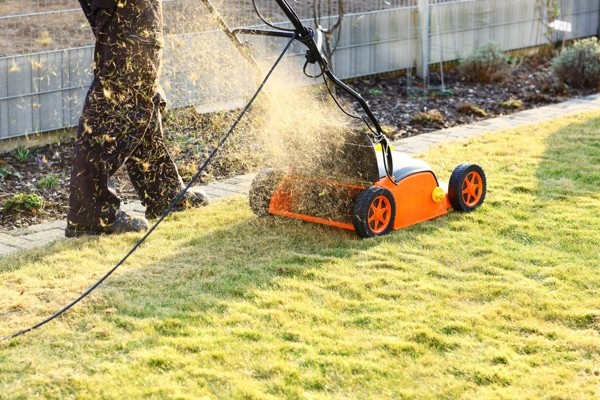Turf & Lawn Blog
When to Scarify a Lawn
Scarifying generally refers to the process of cutting and removing debris from a lawn with the use of a scarifier. Raking can achieve the same results but is much more time consuming and labour intensive. Initially scarifying often has a detrimental effect on the appearance of a lawn, but if you do it correctly it should recover and look healthier than ever.
It is crucial to know when to scarify so that your lawn can repair as quickly as possible following this procedure. Even if you do a good job scarifying, doing it at the wrong time of year or in unfavourable conditions can damage your lawn permanently; it is essential to time it correctly.

Firstly, it is important to consider the current state of you lawn. If your lawn is not growing well prior to scarifying, it is a relatively useless course. If, however, your lawn is lush and you have good growing conditions, scarifying can be extremely beneficial for both thatch and moss lawns.
You should aim to perform scarifying before a period of warmth, sun and precipitation; seeking to avoid excessive cold, heat or drought. Autumn is the prime time for heavy scarifying; late August to early September is usually the most recommended time for a deep rake.
Heavy scarifying is going to expose the soil and thin your lawn which in turn creates an ideal seed bed. The advantage of a perfect seed bed is that new and improved grass seed can burgeon, which is what you want, but the disadvantage is that unwanted weed and weed grass seeds can also grow.
By performing the scarifying process in Autumn, you should successfully avoid the bulk of the years weed seeds. This is why it is favourable to perform heavy scarifying or raking at this time of year. Intense scarifying should be limited to dense thatch or moss lawns that are sure to recover from a deep infiltration.
Whilst it is recommended to scarify your lawn at the start of Autumn, you can rake and lightly scarify at the beginning of Spring, generally in April. Light de-thatching of moss lawns in April, just as temperatures are starting to rise, should improve growth and recovery before the more intense heat of summer relinquishes this chance for growth.
If you have a shady or troublesome area of lawn, a deep scarify of these areas should be avoided. Instead, perform a light spring scarify for areas where the lawn is weak. The same applies for patches that are under trees, as the optimum time for grass seed to grow in these areas is in Spring. If you missed the chance to perform a heavy scarify in Autumn, a light rake in April time can be highly beneficial if you have a strong lawn.
Make sure your lawn is ready for scarifying by gradually cutting down grass length for a week or two beforehand, to prepare the grass and to allow air to get deeper into the turf. A day or two before you plan to scarify, trim the lawn as close as possible, but avoid scalping. Weeds in your lawn should be removed up to a week preceding. Make sure to have optimum soil moisture to allow the lawn to recover quickly after scarifying, and perform scarifying when the grass is dry with no dew present.
If you are looking to buy turf online, or would like advise about which turf would best suit your gardening needs, Contact Turf Growers and one of our expert team of advisers will be happy to help.
When you subscribe to the blog, we will send you an e-mail when there are new updates on the site so you wouldn't miss them.
